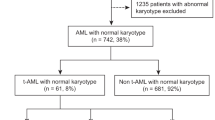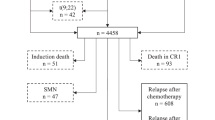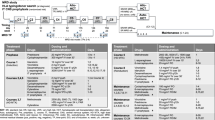Abstract
Karyotype is an important prognostic factor in patients with newly diagnosed acute myeloblastic leukaemia (AML). The prognostic value of cytogenetics on the outcome of patients with AML in relapse has not yet been well defined. We analysed the clinical outcome of 152 patients with de novo, chemotherapy-treated AML in first relapse according to the cytogenetic classification of the United Kingdom Medical Research Council. The rate of second complete remission (CR) (88, 64 and 36%) and the probability of survival at 3 years (43, 18 and 0%) were significantly different between the favourable, intermediate and adverse cytogenetic risk groups, respectively. Compared to the favourable group, the relative risk (RR) of death (multivariate analyses) was 2.6 (confidence interval (CI): 1.5–4.4, P<0.001) for the intermediate and 3.7 (CI: 1.7–7.9, P=0.001) for the adverse group. The prognostic value of the duration of first CR was confirmed (RR of death: 2.0 (CI: 1.0–4.0) for each additional year in first CR), whereas the FLT3 mutation obtained at diagnosis did not markedly influence the outcome of patients with AML in relapse. In conclusion, our results indicate that both karyotype and the duration of first CR are independent prognostic factors for patients with de novo AML in first relapse.
This is a preview of subscription content, access via your institution
Access options
Subscribe to this journal
Receive 12 print issues and online access
$259.00 per year
only $21.58 per issue
Buy this article
- Purchase on Springer Link
- Instant access to full article PDF
Prices may be subject to local taxes which are calculated during checkout




Similar content being viewed by others
References
Mayer RJ, Davis RB, Schiffer CA, Berg DT, Powell BL, Schulman P et al. Intensive postremission chemotherapy in adults with acute myeloid leukemia. Cancer and Leukemia Group B. N Engl J Med 1994; 331: 896–903.
Appelbaum FR, Kopecky KJ . Long-term survival after chemotherapy for acute myeloid leukemia: the experience of the Southwest Oncology Group. Cancer 1997; 80: 2199–2204.
Burnett AK, Goldstone AH, Stevens RM, Hann IM, Rees JK, Gray RG et al. Randomised comparison of addition of autologous bone-marrow transplantation to intensive chemotherapy for acute myeloid leukaemia in first remission: results of MRC AML 10 trial. Lancet 1998; 351: 700–708.
Stevens RF, Hann IM, Wheatley K, Gray RG . Marked improvements in outcome with chemotherapy alone in paediatric acute myeloid leukemia: results of the United Kingdom Medical Research Council's 10th AML trial. Br J Haematol 1998; 101: 130–140.
Berger R, Flandrin G, Bernheim A, Le Coniat M, Vecchione D, Pacot A et al. Cytogenetic studies on 519 consecutive de novo acute nonlymphocytic leukemias. Cancer Genet Cytogenet 1987; 29: 9–21.
Keating MJ, Smith TL, Kantarjian H, Cork A, Walters R, Trujillo JM et al. Cytogenetic pattern in acute myelogenous leukemia: a major reproducible determinant of outcome. Leukemia 1988; 2: 403–412.
Fenaux P, Preudhomme C, Lai JL, Morel P, Beuscart R, Bauters F . Cytogenetics and their prognostic value in de novo acute myeloid leukaemia: a report on 283 cases. Br J Haematol 1989; 73: 61–67.
Arthur DC, Berger R, Golomb HM, Swansbury GJ, Reeves BR, Alimena G et al. The clinical significance of karyotype in acute myelogenous leukemia. Cancer Genet Cytogenet 1989; 40: 203–216.
Marosi C, Koller U, Koller-Weber E, Schwarzinger I, Schneider B, Jager U et al. Prognostic impact of karyotype and immunologic phenotype in 125 adult patients with de novo AML. Cancer Genet Cytogenet 1992; 61: 14–25.
Swansbury GJ, Lawler SD, Alimena G, Arthur D, Berger R, Van den Berghe H et al. Long-term survival in acute myelogenous leukemia: a second follow-up of the Fourth International Workshop on Chromosomes in Leukemia. Cancer Genet Cytogenet 1994; 73: 1–7.
Dastugue N, Payen C, Lafage-Pochitaloff M, Bernard P, Leroux D, Huguet-Rigal F et al. Prognostic significance of karyotype in de novo adult acute myeloid leukemia. Leukemia 1995; 9: 1491–1498.
Bloomfield CD, Shuma C, Regal L, Philip PP, Hossfeld DK, Hagemeijer AM et al. Long-term survival of patients with acute myeloid leukemia: a third follow-up of the Fourth International Workshop on Chromosomes in Leukemia. Cancer 1997; 80: 2191–2198.
Grimwade D, Walker H, Oliver F, Wheatley K, Harrison C, Harrison G et al. The importance of diagnostic cytogenetics on outcome in AML: analysis of 1612 patients entered into the MRC AML 10 trial. Blood 1998; 92: 2322–2333.
Slovak ML, Kopecky KJ, Cassileth PA, Harrington DH, Theil KS, Mohamed A et al. Karyotypic analysis predicts outcome of preremission and postremission therapy in adult acute myeloid leukemia: a Southwest Oncology Group/Eastern Cooperative Oncology Group Study. Blood 2000; 96: 4075–4083.
Grimwade D, Walker H, Harrison G, Oliver F, Chatters S, Harrison CJ et al. The predictive value of hierarchical cytogenetic classification in older adults with acute myeloid leukemia (AML): analysis of 1065 patients entered into the United Kingdom Medical Research Council AML11 trial. Blood 2001; 98: 1312–1320.
Byrd JC, Mrozek K, Dodge RK, Carroll AJ, Edwards CG, Arthur DC et al. Pretreatment cytogenetic abnormalities are predictive of induction success, cumulative incidence of relapse, and overall survival in adult patients with de novo acute myeloid leukemia: results from Cancer and Leukemia Group B (CALB 8461). Blood 2002; 100: 4325–4336.
Archimbaud E, Leblond V, Michallet M, Cordonnier C, Fenaux P, Travade P et al. Intensive sequential chemotherapy with mitoxantrone and continuous infusion etoposide and cytarabine for previously treated acute myelogenous leukemia. Blood 1991; 77: 1894–1900.
Vogler WR, McCarley DL, Stagg M, Bartolucci AA, Moore J, Martelo O et al. A phase III trial of high-dose cytosine arabinoside with or without etoposide in relapsed and refractory acute myelogenous leukemia. Leukemia 1994; 8: 1847–1853.
Archimbaud E, Thomas X, Leblond V, Michallet M, Fenaux P, Cordonnier C et al. Timed sequential chemotherapy for previously treated patients with acute myeloid leukemia: long-term follow-up of the etoposide, mitoxantrone, and cytarabine-86 trial. J Clin Oncol 1995; 13: 11–18.
Willemze R, Suciu S, Archimbaud E, Muus P, Stryckmans P, Louwagie EA et al. A randomized phase II study on the effects of 5-aza-2′-deoxycytidine combined with either amsacrine or idarubicin in patients with relapsed acute leukemia: an EORTC Leukemia Cooperative Group phase II study (06893). Leukemia 1997; 11 (Suppl 1): S24–S27.
Smits P, Schoots L, de Pauw BE, de Witte T, Holdrinet RS, Janssen JT et al. Prognostic factors in adult patients with acute leukemia at first relapse. Cancer 1987; 59: 1631–1634.
Keating MJ, Kantarjian H, Smith TL, Estey E, Walters R, Andersson B et al. Response to salvage therapy and survival after relapse in acute myelogenous leukemia. J Clin Oncol 1989; 7: 1071–1080.
Hiddemann W, Martin WR, Sauerland CM, Heinecke A, Buchner T . Definition of refractoriness against conventional chemotherapy in acute myeloid leukemia: a proposal based on the results of retreatment by thioguanine, cytosine arabinoside, and daunorubicin (TAD 9) in 150 patients with relapse after standardized first line therapy. Leukemia 1990; 4: 184–188.
Davis CL, Rohatiner AZ, Lim J, Whelan JS, Oza AM, Amess J et al. The management of recurrent acute myelogenous leukaemia at a single centre over a fifteen-year period. Br J Haematol 1993; 83: 404–411.
Kantarjian HM, Keating MJ, Walters RS, McCredie KB, Freireich EJ . The characteristics and outcome of patients with late relapse acute myelogenous leukemia. J Clin Oncol 1988; 6: 232–238.
Thalhammer F, Geissler K, Jager U, Kyrle PA, Pabinger I, Mitterbauer M et al. Duration of second complete remission in patients with acute myeloid leukemia treated with chemotherapy: a retrospective single-center study. Ann Hematol 1996; 72: 216–222.
Kern W, Schoch C, Haferlach T, Braess J, Unterhalt M, Wormann B et al. Multivariate analysis of prognostic factors in patients with refractory and relapsed acute myeloid leukemia undergoing sequential high-dose cytosine arabinoside and mitoxantrone (S-HAM) salvage therapy: relevance of cytogenetic abnormalities. Leukemia 2000; 14: 226–231.
Webb DK, Wheatley K, Harrison G, Stevens RF, Hann IM . Outcome for children with relapsed acute myeloid leukaemia following initial therapy in the Medical Research Council (MRC) AML 10 trial. Leukemia 1999; 13: 25–31.
Kern W, Haferlach T, Schnittger S, Ludwig WD, Hiddemann W, Schoch C . Karyotype instability between diagnosis and relapse in patients with acute myeloid leukemia: implications for resistence against therapy. Leukemia 2002; 16: 2084–2091.
Stoiser B, Knobl P, Fonatsch C, Haas OA, Mitterbauer G, Weltermann A et al. Prognosis of patients with a second relapse of acute myeloid leukemia. Leukemia 2000; 14: 2059–2063.
Agis H, Weltermann A, Fonatsch C, Haas O, Mitterbauer G, Mullauer L et al. A comparative study on demographic, hematological, and cytogenetic findings and prognosis in acute myeloid leukemia with and without leukemia cutis. Ann Hematol 2002; 81: 90–95.
Laczika K, Mitterbauer G, Korninger L, Knobl P, Schwarzinger I, Kapiotis S et al. Rapid achievement of PML-RAR alpha polymerase chain reaction (PCR)-negativity by combined treatment with all-trans-retinoic acid and chemotherapy in acute promyelocytic leukemia: a pilot study. Leukemia 1994; 8: 1–5.
Mitterbauer M, Kusec R, Schwarzinger I, Haas OA, Lechner K, Jaeger U . Comparison of karyotype analysis and RT-PCR for AML1/ETO in 204 unselected patients with AML. Ann Hematol 1998; 76: 139–143.
Mitterbauer M, Laczika K, Novak M, Mitterbauer G, Hilgarth B, Pirc-Danoewinata H et al. High concordance of karyotype analysis and RT-PCR for CBFbeta/MYH11 in unselected patients with acute myeloid leukemia. Am J Clin Pathol 2000; 113: 406–410.
Kiyoi H, Naoe T, Yokota S, Nakao M, Minami S, Kuriyama K et al. Internal tandem duplication of FLT3 associated with leukocytosis in acute promyelocytic leukemia. Leukemia 1997; 11: 1447–1452.
Kainz B, Heintel D, Marculescu R, Schwarzinger I, Sperr W, Le T et al. Variable prognostic value of FLT3 internal tandem duplications in patients with de novo AML and a normal karyotype, t(15;17), t(8;21) or inv(16). Hematol J 2002; 3: 283–289.
Kaplan EL, Meier P . Nonparametric estimation from incomplete observations. J Am Stat Assoc 1958; 53: 457–481.
Marubini E, Valsecchi MG . Analysing Survival Data from Clinical Trials and Observational Studies. Chichester, UK: John Wiley, 1995.
Vignetti M, Orsini E, Petti MC, Moleti ML, Andrizzi C, Pinto RM et al. Probability of long-term disease-free survival for acute myeloid leukemia patients after first relapse: a single-centre experience. Ann Oncol 1996; 7: 933–938.
Stahnke K, Boos J, Bender-Gotze C, Ritter J, Zimmermann M, Creutzig U . Duration of first remission predicts remission rates and long-term survival in children with relapsed acute myelogenous leukemia. Leukemia 1998; 12: 1534–1538.
Estey E, Keating MJ, Pierce S . Change in karyotype between diagnosis and first relapse in acute myelogenous leukemia. Leukemia 1995; 9: 972–976.
Kottaridis PD, Gale RE, Frew ME, Harrison G, Langabeer SE, Belton AA et al. The presence of a FLT3 internal tandem duplication in patients with acute myeloid leukemia (AML) adds important prognostic information to cytogenetic risk group and response to the first cycle of chemotherapy: analysis of 854 patients from the United Kingdom Medical Research Council AML 10 and 12 trials. Blood 2001; 98: 1752–1759.
Schnittger S, Schoch C, Dugas M, Kern W, Staib P, Wuchter C et al. Analysis of FLT3 length mutations in 1003 patients with acute myeloid leukemia: correlation to cytogenetics, FAB subtype, and prognosis in the AMLCG study and usefulness as a marker for the detection of minimal residual disease. Blood 2002; 100: 59–66.
Shih LY, Huang CF, Wu JH, Lin TL, Dunn P, Wang PN et al. Internal tandem duplication of FLT3 in relapsed acute myeloid leukemia: a comparative analysis of bone marrow samples from 108 adult patients at diagnosis and relapse. Blood 2002; 100: 2387–2392.
Kottaridis PD, Gale RE, Langabeer SE, Frew ME, Bowen DT, Linch DC . Studies of FLT3 mutations in paired presentation and relapse samples from patients with acute myeloid leukemia: implications for the role of FLT3 mutations in leukemogenesis, minimal residual disease detection, and possible therapy with FLT3 inhibitors. Blood 2002; 100: 2393–2398.
Author information
Authors and Affiliations
Corresponding author
Rights and permissions
About this article
Cite this article
Weltermann, A., Fonatsch, C., Haas, O. et al. Impact of cytogenetics on the prognosis of adults with de novo AML in first relapse. Leukemia 18, 293–302 (2004). https://doi.org/10.1038/sj.leu.2403243
Received:
Accepted:
Published:
Issue Date:
DOI: https://doi.org/10.1038/sj.leu.2403243
Keywords
This article is cited by
-
Emerging agents and regimens for treatment of relapsed and refractory acute myeloid leukemia
Cancer Gene Therapy (2020)
-
Re-induction chemotherapy using FLAG–mitoxantrone for adult patients with relapsed acute leukemia: a single-center experience from United Arab Emirates
International Journal of Hematology (2018)
-
Salvage regimens using conventional chemotherapy agents for relapsed/refractory adult AML patients: a systematic literature review
Annals of Hematology (2018)
-
Homoharringtonine in combination with cytarabine and aclarubicin in the treatment of refractory/relapsed acute myeloid leukemia: a single-center experience
Annals of Hematology (2013)
-
Hox expression in AML identifies a distinct subset of patients with intermediate cytogenetics
Leukemia (2004)



